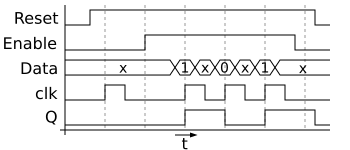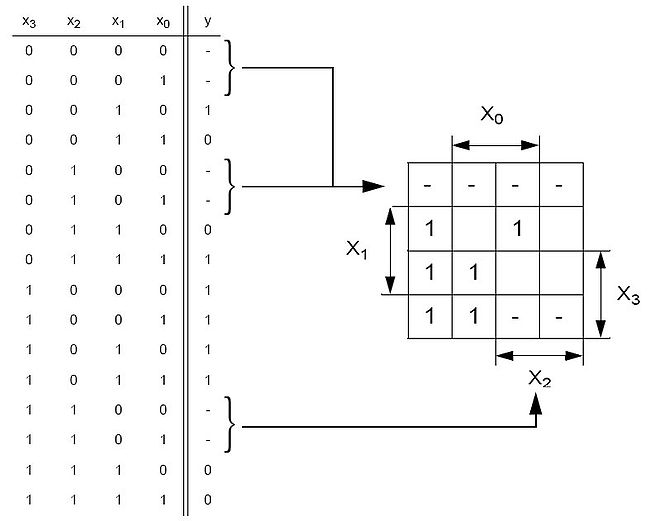Don't care
In digital technology , Don't-Care , X or - means that this value has no influence on the logic circuit.
General
In the truth table , don't care entries are typically used to avoid having to deal with all input states, or if an incompletely defined function occurs, i.e. the variable can have "1" and "0". This is the case for certain input combinations if the output is not defined for them - for example, if these input combinations are not possible or not present in the circuit or are deactivated in the module via the enable signal.
Don't care values are also used in logic synthesis and in the timing diagram . In the function table (truth table) of the flip-flop , an X represents any state that can be either “0” or “1”. The flip-flop only processes the data if the respective trigger condition is met. At all times when the data is not being processed, any logic states can be present at the inputs without these being included in the processing. The timing diagram associated with the respective flip-flops also contains an X for the corresponding time periods if the applied logic state is not relevant.
Example D flip-flop
| symbol | Truth table | Timing diagram | ||||||||||||||||||||||||||||||||||||
|---|---|---|---|---|---|---|---|---|---|---|---|---|---|---|---|---|---|---|---|---|---|---|---|---|---|---|---|---|---|---|---|---|---|---|---|---|---|---|

|
|

|
Don't Cares on the Karnaugh Chart
Practical switch insert
When it comes to practical use, don't-cares have clear advantages. The overall circuit can be significantly more compact when using don't-care in the case of corresponding circuits. For example, the overall circuit can be implemented with a smaller number of individual gates or with components with fewer inputs. This can lead to more cost-effective solutions. At the same time, more compact circuits are often faster if fewer components have to be connected in series.
restrictions
A circuit with don't-cares may only be used in the area for which the don't-cares are valid. The use of this circuit is still permissible if the definition range is further restricted compared to the original definition range. In the other case, in which the definition range is expanded, this circuit may no longer meet the requirements. For example, the circuit can then no longer behave correctly in individual cases.
